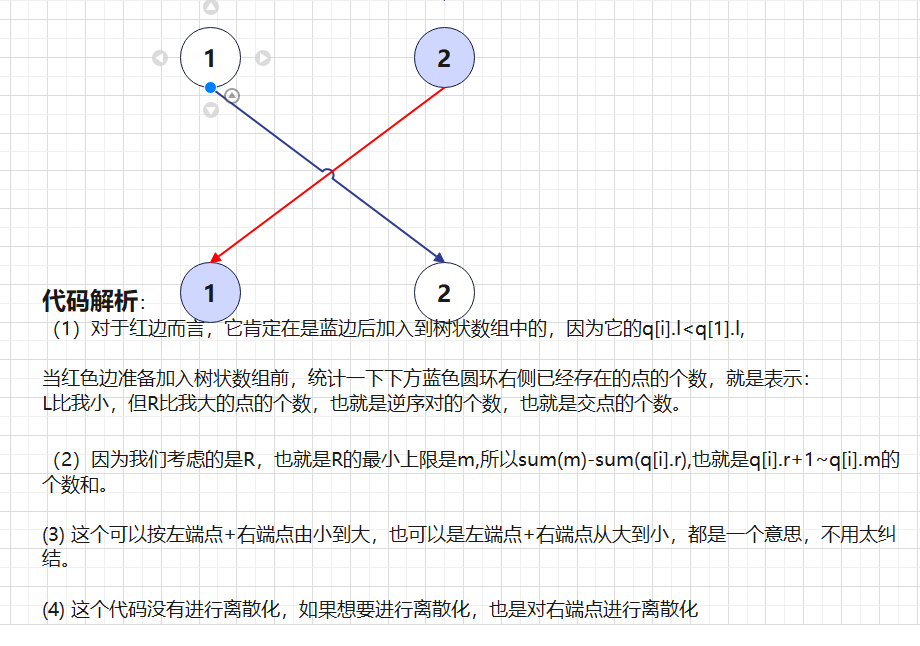You can not select more than 25 topics
Topics must start with a letter or number, can include dashes ('-') and can be up to 35 characters long.
3.9 KiB
3.9 KiB
一、题目大意
两对岸,一边n个点,一边m个点,现在连k条线,问有几个交点。
二、题目解析
梳理一下这其实是一个问逆序对的问题,为什么是逆序对?
举例:
1
3 4 4
1 4
2 3
3 2
3 1

依题意可得上图,算出5个交点,除了作图还有什么方法可以得到答案呢?
我们不妨先把n的元素看成是有序的,例子就是如此(1,2,3,3)对应的是(4, 3, 2, 1)因为有相同的数据存在,相同位的从小到大排序(4,3,1,2),如果这个结果是(1,2,3,4)的话,是不是就没有交点了,因为 没有逆序对存在。
把逆序对互换直到为零,操作步数就是5,其实每添加一条线,增加的点数就是增加的逆序对数,还无法理解就按上述步骤模拟几组数据,明白要干什么。
剩下的就是非常经典的求逆序对问题了。
步骤:
- 将每条线段封装成结构体,并且,按左端点由小到大排序,如果左端点一致,则按右端点由小到大排序。(这似乎是最终无逆序时的顺序)
- 从小到大,逐个进入树状数组,在每条边进入时,检查是不是已经存在,左端点比自己小,或者左端点一致,但右端点比自己小的边,已经出现在了自己的右侧,这样的话,这种边就会与自己形成一个逆序。
由小到大排序+树状数组
#include <cstdio>
#include <string.h>
#include <algorithm>
#include <iostream>
using namespace std;
typedef long long LL;
const int N = 1e6 + 10;
int n, m;
struct Node {
int l, r;
const bool operator<(const Node &t) const {
if (l == t.l) return r < t.r;
return l < t.l;
}
} q[N];
// 树状数组模板
#define lowbit(x) (x & -x)
int c[N];
void add(int x, int v) {
while (x < N) c[x] += v, x += lowbit(x);
}
LL sum(int x) {
LL res = 0;
while (x) res += c[x], x -= lowbit(x);
return res;
}
int main() {
#ifndef ONLINE_JUDGE
freopen("POJ3067.in", "r", stdin);
#endif
int T;
scanf("%d", &T);
int cnt = 0;
while (T--) {
memset(c, 0, sizeof c);
int k;
scanf("%d %d %d", &n, &m, &k); // 左右两边分别有n和m个城市,然后k行给出连边,问共有多少交叉点
for (int i = 1; i <= k; i++) scanf("%d %d", &q[i].l, &q[i].r);
sort(q + 1, q + 1 + k); // 按左端点由小到大,右端点由小到大排序
// 没有离散化
// Q:为什么这里不使用离散化呢?为什么前一题 一维逆序对的数量就要使用离散化呢?
// 答:因为前一题的数值1e9,而个数是1e5,所以需要映射到1~1e5的空间上,再用二分快速找出相对位置
// 而本题,数值l,r 与 个数其实是一个概念,都是小于等于1000的,无需离散化。
LL res = 0;
for (int i = 1; i <= k; i++) { // 捋着原数组来,也就是一条边一条边来,逐个进入树状数组
// 当i号边进入树状数组时,在它前面进入的,肯定是左端点比自己小的,也就是值比自己小,
// 那么,就检查出现的位置,也就是对应的出现在自己右侧的端点个数
res += sum(m) - sum(q[i].r); // 注意这里的sum(m),因为考查的是右端点,而右端点的上限是m
add(q[i].r, 1);
}
printf("Test case %d: %lld\n", ++cnt, res);
}
return 0;
}
